The Perma-Building Intensives
We're offering the full PDC (Permaculture Design Certificate)
as a practical intensive as part of the new GaiaSis program, which is now asynchronic!
This means there are no fixed dates: you arrive / a group arrives on site when we see they are ready to, and you choose which of the many building design projects you'd like to work on.
1) we saw we needed more time to explain to people before arriving some basic criteria that we work to, like that we don't do "eco-building" but "perma-building" here, which is now explained in more detail in the Integral Permaculture course - here in the e-book: http://bit.ly/PermaConstruction
2) we prefer to have people arrive on site when they are well briefed on these & other general principles we work with, as well as well-decided on what specific design they want to work on, and we can also plan the times & logistics well so that they can finish the project in the time they can stay on site.
2) also we tried several times to organize small groups of people to arrive at the same time, & it seemed reasonable to give dates ... but in fact this didn't work well in practice, so now we let people self-organize more, with this more flexible system.
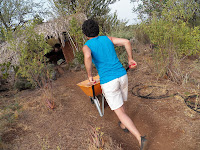
There's lots of 'green gym' work to do on a daily basis on a farm, which is good to keep you quite fit, like moving heavy building materials like clay & stones, carrying spring water up to the kitchen, big bags of compost or straw for mulching, sawdust for the compost toilets, etc.
How it Works
You can see more details in the new GaiaSis Canaries page, http://bit.ly/GaiaSisCanaries but basically what it means is this:
a) you enrol on the on-line part of the course (important preparation) WHENEVER you like - & as soon as possible - which is where you will get to know us, prospective course & building companions AND the projects you will be working with on-site.
b) when we see you're ready to take on the project of your choice, we fix the on-site dates & details together & look forward to your arrival.
c) if you complete an agreed infrastructure design in a satisfactory way (it's usable, up to standard & it was mainly done by your efforts) we can pay you in Gaias for it >> which are transferable as part-payment for shares in the EcoVillage.
Examples of Design Projects
of projects that you can choose to be involved in - there are many others, these are just a sample.
Food Growing
This means that we have plenty of space & scope for some more intensive growing, which is ideal for someone who wants to design a whole garden from scratch, plant, maintain & harvest it.
Because with the online-learning & design time, we can do interesting team-work things like get the nursery plants going before you arrive, so you have however many plants & varieties you decide waiting for you, you will have worked out the preparation & growing times together with us & be well on the way to becoming an expert garden manager by the time you've completed your project.
Forest Gardening

We have 8 embryonic forest-gardens on site, and if you wish to focus on trees, soil conditioning, making & improving swales, paths, hedges, etc. there is plenty still to design & plant in each of these sites.
Our vision is that each of these small forest gardens will eventually join up into a big edible forest, which will be the whole site, but this takes quite a few years to all grow, and for now, building soil & planting more & more varieties is still a priority.
The idea is that each part will have it's own character, own peculiar art, cosy sitting-places, wide variety of food growing with least effort.
Hobbit domes
One of the more adventurous (& controversial) projects that we started on site is an experiment in making small "hobbit-domes" with 90% waste materials.
This means finding creative ways of working with things like:
- plastic bales instead of straw-bales (in order to find good uses for the huge quantities of plastics which are currently causing havoc in landfills & the oceans)
- using cardboard as a building material (quite challenging also, but has great structural qualities, as well as being plentiful waste material from the banana industry here)
- old car tyres, metal fencing, palets ... whatever is normally pollution & can become a valuable resource, with some imagination & skill.
Eventually the vision for the domes is that they be covered with a thin fire-proof, water-proof ferro-cement shell that will in turn be a support-structure for climbing plants - so they can disappear totally in the landscape.
At the moment we have a 3 early prototypes at various stages of building, all of which are habitable, if very basic still.
Here is a short video we made in spanish about this (it's called Transforming Rubbish into Dreams & is presented as a crowd-funding project - which you are very welcome to use if you wish to fund your stay in a very original way)
Plant nursery
The idea is that the guinea-pigs live inside the greenhouse, providing plants with Co2, compost & heat, in exchange for being in a nice warm sheltered place, where we can see them every time we pass through the greenhouse on the way to the camping site or the house, as the new structure will act also as a corridor in a well-transited place.
In autumn 2012 we started a guinea-pig -breeding project, in a small way, to see if these 'little pigs' are fairly easy to keep ... & as tasty as they claim.
Chicken house
A large-scale chicken-tractor project, that will eventually join up the 6 big half-moon terraces & gardens is still being designed.
It aims to provide enough chicken meat & eggs for a small community - & of course also all the great de-bugging & fertilizing services that these wonderful creatures offer.
The Flora Garden with some of the big chicken-house structure visible - still being built.
This will eventually be the centre of the big chicken-tractor system, & we'll be experimenting with green walls & other interesting things.
Solar Showers
The solar shower is still the basic bottles + black pipes structure we built in our first months here, & it works fine most of the time, but it's a little cold in winter.
We could do with more showers, so there's scope for much creativity as there are lots of ways they can be designed, ... eg. as an integral part of a wood-heated sauna-spar complex that we are fantasizing about from time ... :)
Just this simple shower can be improved by building a compost-heated winter version & by adding a storage tank for hot water.
Compost Toilets
Again, very basic, we still have the old sawdust bucket-system
& since it works well enough & we have so many other things to do ...
that means there's still lots of scope for experimenting & building various toilets of different types here, if anyone has the enthusiasm to organize it.
Sheep Pens
We have milk sheep which provide us with great compost for our trees & gardens, wool, meat & daily meditative walks ... as well as the milk, eventually, when we breed them (these are youngsters still).
We have a small pen for them & have decided to move them to another part of the farm where we can build them a larger space, with more roofed space, a bigger place for all the wonderful compost they produce (which could warm the water for a new shower).
To Enrol
we look forward to seeing you in the Integral Permaculture facebook group
linked to that page, if you wish to clarify & ask questions etc.
Traditional Canarian buildings use the plentiful vulcanic stone we have available here, a great building material.
So we have a lot of old stone walls to repair & some buildings to restore.

Compost Toilet & Solar Shower entrances.
Light Live Building structures.
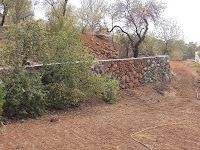
The Palmeros are famous for their stone-building skill & we had some masters work with us to repair the ancient terracing which makes more of the slopy land available & easy for growing food.
Han's tyre stair-case design.
A very well made staircase, transforming waste materials into very useful beauty.
Almonds in flower: every January we are treated to the most amazing spectacle, as the hills here are covered in almond trees, so different shades of white & pink cover the landscape for many weeks in the coldest months of winter (which isn't very cold)
All well-finished infrastructure improvements we pay in Gaias, and you can trade Gaias for EcoVillage shares, if you wish.
Design is about being scientific & being creative, about thinking through all the details & also being daring about starting even when you're not quite sure how it will work out.
We love living with interesting people who have or want to develop these important skills, and, like us, wish to apply them to creating the infrastructures for a more sustainable society.

We fondly remember & are always grateful to all the wonderful people who have left their gifts of intelligence, love & creativity in this landscape.
This project was meant from the start as a place to be designed by many people, and we are love to see the results of that aim flourishing all around us each day.
Thank-you to all the people who made it happen, and to those who continue the good work.
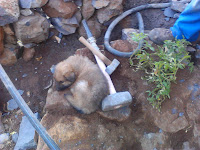


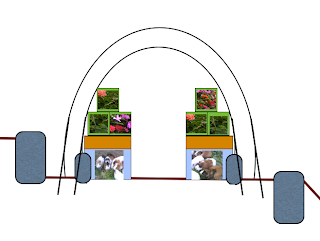
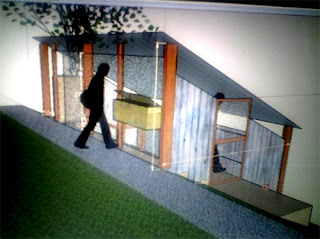



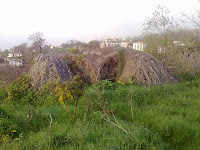
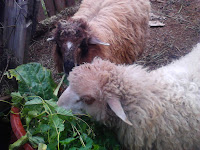




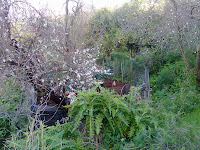

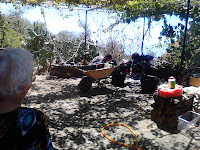







No comments: